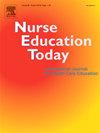Simulation as a foundation for experiential learning among ambulance nursing students: A qualitative observation study
IF 3.6
2区 医学
Q1 EDUCATION, SCIENTIFIC DISCIPLINES
引用次数: 0
Abstract
Simulation-based education is commonly used in undergraduate training but has gained increased utilization in postgraduate education. Ambulance nursing programs struggle to provide suitable simulations, as ambulance care can involve any possible situation. Simulation-based education in ambulance nursing programs commonly includes basic assessment and treatment of various conditions. However, there seems to be a lack of knowledge regarding students' experience of simulating pediatric emergency care in an ambulance care setting. Thus, the aim of this study was to explore specialist nursing students' experiences of simulating pediatric emergency care in an ambulance care setting. A qualitative design was deployed, utilizing field notes, individual and group interviews to capture the students' experiences. The results show that students immerse themselves in the simulations when the environment and facilitators support this. The simulation can elicit both emotional and physical responses among the students. Students gain insights into their knowledge deficit regarding certain topics, such as pediatric emergency care, as well as the rules and regulations governing what they are allowed to do for a child's safety and well-being. During simulation, students understand the importance of using adequate communication and recognize that there might be several aspects influencing this. Finally, the students gain insight into their emotional and behavioral responses when encountering patients and relatives in situations that conflict with their own views. In conclusion, simulation-based education can be a useful pedagogical tool if barriers to immersion are reduced. It can provide students with insights into their emotional and behavioral responses when encountering unexpected events. If properly discussed in debriefing sessions, these matters lead to increased learning that students can carry with them into their future careers. However, more research is needed on the feasibility of this kind of simulation in the ambulance nurse education setting.
模拟作为急救护理学生体验式学习的基础:一项定性观察研究
基于模拟的教育通常用于本科培训,但在研究生教育中得到了越来越多的应用。救护车护理程序努力提供合适的模拟,因为救护车护理可以涉及任何可能的情况。在救护车护理项目中,以模拟为基础的教育通常包括各种情况的基本评估和治疗。然而,似乎缺乏关于学生在救护车护理环境中模拟儿科急诊护理经验的知识。因此,本研究的目的是探讨专科护理学生在救护车护理环境中模拟儿科急诊护理的经验。采用定性设计,利用实地记录、个人和小组访谈来捕捉学生的经历。结果表明,在环境和辅导员的支持下,学生可以沉浸在模拟中。模拟可以引起学生的情绪和身体反应。学生将深入了解他们在某些主题方面的知识缺陷,例如儿科急诊护理,以及管理他们为孩子的安全和福祉允许做什么的规则和条例。在模拟过程中,学生理解充分沟通的重要性,并认识到可能有几个方面影响这一点。最后,学生们将深入了解他们在遇到与自己观点相冲突的病人和亲属时的情绪和行为反应。总之,如果能够减少沉浸式教育的障碍,基于模拟的教育将成为一种有用的教学工具。它可以让学生了解自己在遇到意外事件时的情绪和行为反应。如果在汇报会议上进行适当的讨论,这些问题会增加学生的学习,并将其带入未来的职业生涯。然而,这种模拟在救护护士教育环境中的可行性还需要更多的研究。
本文章由计算机程序翻译,如有差异,请以英文原文为准。
求助全文
约1分钟内获得全文
求助全文
来源期刊

Nurse Education Today
医学-护理
CiteScore
6.90
自引率
12.80%
发文量
349
审稿时长
58 days
期刊介绍:
Nurse Education Today is the leading international journal providing a forum for the publication of high quality original research, review and debate in the discussion of nursing, midwifery and interprofessional health care education, publishing papers which contribute to the advancement of educational theory and pedagogy that support the evidence-based practice for educationalists worldwide. The journal stimulates and values critical scholarly debate on issues that have strategic relevance for leaders of health care education.
The journal publishes the highest quality scholarly contributions reflecting the diversity of people, health and education systems worldwide, by publishing research that employs rigorous methodology as well as by publishing papers that highlight the theoretical underpinnings of education and systems globally. The journal will publish papers that show depth, rigour, originality and high standards of presentation, in particular, work that is original, analytical and constructively critical of both previous work and current initiatives.
Authors are invited to submit original research, systematic and scholarly reviews, and critical papers which will stimulate debate on research, policy, theory or philosophy of nursing and related health care education, and which will meet and develop the journal''s high academic and ethical standards.
 求助内容:
求助内容: 应助结果提醒方式:
应助结果提醒方式:


